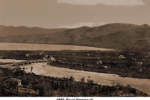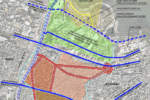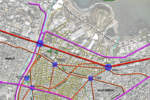The Bourj-Hammoud district is the geographical extension of Beirut City along the Mediterranean coastline; it constitutes the immediate eastern suburb of the capital by the seaside separated from it by the Beirut River, and the northern stretch of the popular suburban belt surrounding the Capital.Housing a population roughly estimated at 90,000 persons, it is a compact district, extending over an area of 2.4 km2, within the Greater Beirut conurbation, with distinctive traits due both to its location and socio-economic characteristics, wherefrom stems the problematic of its development. Until early last century, the area was agricultural and marsh lands, with scattered individual buildings, when Armenian refugees who had survived the Ottoman persecution started settling in the area, in compact quarters organized in regular gridiron patterns with primitive shelters. Since, the district has evolved to a densely populated area, an active commercial pole and an industrial and handicraft activities hub, characterized by the concentration of small and micro enterprises. After mid last century, the District witnessed continuous population mutations, mainly after 1975, with drastic population movements as a consequence of the Lebanese conflicts’ evolution, which contributed to the gradual degradation and pauperization of its residential neighborhoods. As the main gate of the Capital to the country’s northern and eastern regions and beyond, it was traversed by rapid transit arteries connecting the capital and the regions, and cutting the district into disconnected slices. Two main zones could be distinguished: the areas north of the Beirut-North highway which is an industrial zone. Its coastal frontage that is mostly reclaimed land on the sea includes a fishermen’s port and a waste dump hill 49 meters high, with the remaining coastal stretch allocated for the installation of a sewage treatment plant serving an extended area of 50 municipalities up to Mount Lebanon.
It is badly deteriorated environmentally and treated by the central administration as the backyard of the Capital and the surrounding areas and constitutes a sinistered area.
The areas south of the Beirut-North highway are dense and mixed use residential, commercial and handicraft neighborhoods, sliced by the crossing arteries and the main streets, where the neighborhoods develop in fine grain urban tissues. Commercial activities flourish along the main streets, while the internal areas predominantly residential are in rather deteriorating situation, with the outflow of its population that have ameliorated their economic status while the status of the area have been downgraded to a popular residential area.
The municipality is engaged in a sustainable development strategy establishing several partnerships with international institutions with the following main orientations: a master plan has been developed for the environmental and future evolution of the industrial zone as a business and light industrial (employment intensive) area, and the adequate gate of the Capital from the north. The reclamation of the coastal seashore and its transformation into a maritime leisure park serving the surrounding densely populated areas, including the fishermen’s port and the various necessary infrastructure services after the drastic revision of their planning, rendering them environmentally friendly, and their integration into the projected park, in a complete auto financed package through the exploitation of abandoned maritime domains in the area. The regeneration of the residential neighborhoods and upgrading of their status through the establishment of private-public co-partnership operations addressing urban blocks as a whole, with the aim of maintaining its population in place and providing attractive modest housing opportunities at proximity to the Capital.
Diran Harmandayan is the general manager of Architecture Planning & Engineering Consultants, where he directs planning, development, and urban and architectural design studies in the Middle East, mainly Lebanon. He has a long and diversified experience in consultancy services, study and research, 34 years, and academic involvement, 24 years (INBA, AUB), in planning development and design









